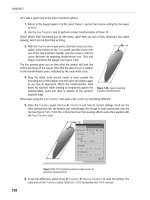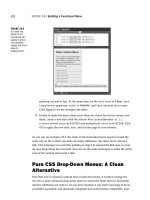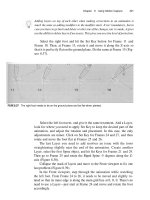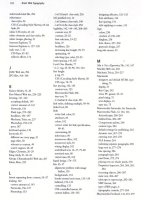Internetworking with TCP/IP- P12 pps
Bạn đang xem bản rút gọn của tài liệu. Xem và tải ngay bản đầy đủ của tài liệu tại đây (521.78 KB, 10 trang )
78
Mapping Internet Addresses
To
Physical Addresses
(ARP)
Chap. 5
machine
B
across a physical network to which they both attach, but
A
has only B's in-
ternet address
IB.
The question arises: how does
A
map that address to B's physical ad-
dress,
PB?
Address mapping must be performed at each step along a path from the original
source to the ultimate destination.
In
particular, two cases arise. First, at the last step
of delivering a packet, the packet must be sent across one physical network to its final
destination. The computer sending the packet must map the final destination's Internet
address to the destination's physical address. Second, at any point along the path from
the source to the destination other than the final step, the packet must be sent to an in-
termediate router. Thus, the sender must map the intermediate router's Internet address
to a physical address.
The problem of mapping high-level addresses to physical addresses is known as
the
address resolution problem
and has been solved in several ways. Some protocol
suites keep tables in each machine that contain pairs of high-level and physical ad-
dresses. Others solve the problem by encoding hardware addresses in high-level ad-
dresses. Using either approach exclusively makes high-level addressing awkward at
best. This chapter discusses two techniques for address resolution used by
TCPIIP pro-
tocols and shows when each is appropriate.
5.3
Two Types
Of
Physical Addresses
There are two basic types of physical addresses, exemplified by the Ethernet,
which has large, fixed physical addresses, and proNET, which has small, easily config-
ured physical addresses. Address resolution is difficult for Ethernet-like networks, but
easy for networks like proNET. We will consider the easy case first.
5.4
Resolution Through Direct Mapping
Consider a proNET token ring network. Recall from Chapter
2
that proNET uses
small integers for physical addresses and allows the user to choose a hardware address
when installing an interface board in a computer. The key to making address resolution
easy with such network hardware lies
in
observing that as long as one has the freedom
to choose both
IP
and physical addresses, they can be selected such that parts of them
are the same. Typically, one assigns
IP
addresses with the hostid portion equal to
1,
2,
3,
and so on, and then, when installing network interface hardware, selects a physical
address that corresponds to the
IP
address. For example, the system administrator
would select physical address
3
for a computer with the
IP
address
192.5.48.3
because
192.5.48.3
is a class
C
address with the host portion equal to
3.
For networks like proNET, computing a physical address from an
IP
address is
trivial.
The computation consists of extracting the host portion of the
IP
address. Ex-
traction is computationally efficient on most architectures because it requires only a few
machine instructions. The mapping is easy to maintain because it can be performed
Sec.
5.4 Resolution Through
Direct
Mapping
79
without reference to external data. Finally, new computers can
be
added to the network
without changing existing assignments or recompiling code.
Conceptually, choosing a numbering scheme that makes address resolution effi-
cient means selecting a function
f
that maps
IP
addresses to physical addresses. The
designer may be able to select a physical address numbering scheme
as
well, depending
on the hardware. Resolving
IP
address
IA
means computing
We want the computation off to
be
efficient.
If
the set of physical addresses is con-
strained, it may
be
possible to arrange efficient mappings other than the one given in
the example above. For instance, when using
IP
over a connection-oriented network
such as ATM, one cannot choose physical addresses.
On
such networks, one or more
computers (servers) store pairs of addresses, where each pair contains an Internet ad-
dress and the corresponding physical address. Typically, such servers store the pairs in
a table in memory to speed searching. To guarantee efficient address resolution in such
cases, software can use a conventional hash function to search the table. Exercise
5.1
suggests a related alternative.
5.5
Resolution Through Dynamic Binding
To understand why address resolution is difficult for some networks, consider Eth-
ernet technology. Recall from Chapter
2
that each Ethernet interface is assigned a
48-
bit physical address when the device is manufactured. As a consequence, when
hardware fails and requires that an Ethernet interface
be
replaced, the machine's physi-
cal address changes. Furthermore, because the Ethernet address is
48
bits long, there is
no hope it can be encoded in a 32-bit
IP
addresst.
Designers of TCPLP protocols found a creative solution to the address resolution
problem for networks like the Ethernet that have broadcast capability. The solution al-
lows new hosts or routers to
be
added to the network without recompiling code, and
does not require maintenance of a centralized database. To avoid maintaining a table of
mappings, the designers chose to use a low-level protocol to bind addresses dynamical-
ly. Termed the
Address Resolution Protocol (ARP),
the protocol provides a mechanism
that is both reasonably efficient and easy to maintain.
As Figure
5.1
shows, the idea behind dynamic resolution with
ARP
is simple:
when host
A
wants to resolve
IP
address
ZB,
it broadcasts a special packet that asks the
host with
IP
address
le
to respond with its physical address,
PB.
AU
hosts, including
B,
receive the request, but only host
B
recognizes its
IP
address and sends a reply that con-
tains its physical address. When
A
receives the reply, it uses the physical address to
send the internet packet directly to
B.
We can summarize:
tBecause
direct
mapping is more convenient and efficient
than
dynamic binding, the next generation of
IP
is being designed to allow 48-bit hardware addresses to be encoded in
IP
addresses.
Mapping Internet Addresses
To
Physical Addresses
(ARP)
Chap.
5
The Address Resolution Protocol, ARP, allows a host to
find
the phy-
sical address of a target host on the same physical network, given
only the target's IP address.
Figure
5.1
The
ARP
protocol. To determine
PB,
B's physical address,
from
IB,
its
IP
address, (a) host
A
broadcasts an
ARP
request containing
IB
to all machines on the net, and
(b)
host B responds with
an
ARP
reply that contains the pair
(Is, PB).
5.6
The Address Resolution Cache
It may seem silly that for
A
to send a packet to
B
it first sends a broadcast that
reaches
B.
Or
it may seem even sillier that
A
broadcasts the question, "how can I reach
you?" instead of just broadcasting the packet it wants to deliver. But there
is
an impor-
tant reason for the exchange. Broadcasting is
far
too expensive to be used every time
one machine needs to transmit a packet to another because every machine on the net-
work must receive and process the broadcast packet.
Sec.
5.7
ARP Cache
Timeout
5.7
ARP
Cache
Timeout
To reduce communication costs, computers that use ARP maintain a cache of re-
cently acquired IP-to-physical address bindings. That is, whenever a computer sends an
ARP
request and receives an
ARP
reply, it saves the
IP
address and corresponding
hardware address information in its cache for successive lookups. When transmitting a
packet, a computer always looks in its cache for a binding before sending an AFW re-
quest.
If
it finds the desired binding in its
ARP
cache, the computer need not broadcast
on the network. Thus, when two computers on a network communicate, they begin
with an
ARP
request and response, and then repeatedly transfer packets without using
ARP
for each one. Experience shows that because most network communication in-
volves more than one packet transfer, even a small cache is worthwhile.
The AFW cache provides an example of
soj?
state,
a technique commonly used in
network protocols. The name describes a situation in which information can become
"stale" without warning.
In
the case of
ARP,
consider two computers,
A
and
B,
both
connected to an Ethernet. Assume
A
has sent an
ARP
request, and
B
has replied.
Further assume that after the exchange
B
crashes. Computer
A
will not receive any no-
tification of the crash. Moreover, because it already has address binding information for
B
in
its ARP cache, computer
A
will continue to send packets to
B.
The Ethernet
hardware provides no indication that
B
is not on-line because Ethernet does not have
guaranteed delivery. Thus,
A
has no way of knowing when information in its AFW
cache has become incorrect.
To accommodate soft state, responsibility for correctness lies with the owner of the
information. Typically, protocols that implement soft state use timers, with the state in-
formation being deleted when the timer expires. For example, whenever address bind-
ing information is placed in an AFW cache, the protocol requires a timer to be set, with
a typical
timeout being
20
minutes. When the timer expires, the information must be
removed. After removal there are two possibilities.
If
no further packets are sent to the
destination, nothing occurs.
If
a packet must be sent to the destination and there is no
binding present in the cache, the computer follows the normal procedure of broadcasting
an
ARP
request and obtaining the binding.
If
the destination is still reachable, the bind-
ing will again be placed in the
ARP
cache.
If
not, the sender will discover that the des-
tination is off-line.
The use of soft state in
ARP
has advantages and disadvantages. The chief advan-
tage arises from autonomy. First, a computer can determine when information in its
ARP
cache should be revalidated independent of other computers. Second, a sender
does not need successful communication with the receiver or a third party to determine
that a binding has become invalid;
if
a target does not respond to an
ARP
request, the
sender will declare the target to be down. Third, the scheme does not rely on network
hardware to provide reliable transfer. The chief disadvantage of soft state arises from
delay
-
if the timer interval is
N
seconds, a sender may not detect that a receiver has
crashed until
N
seconds elapse.
82
Mapping Internet Addresses
To
Physical Addresses
(ARP)
Chap.
5
5.8
ARP Refinements
Several refinements of
ARP
have been included in the protocol.
First,
observe that
if host A is about to use
ARP
because it needs to send to B, there is a high probability
that host B will need to send to A in the near future. To anticipate B's need and avoid
extra network traffic, A includes its IP-to-physical address binding when sending
B a re-
quest.
B
extracts A's binding from the request, saves the binding in its
ARP
cache, and
then sends a reply to A. Second, notice that because A broadcasts its initial request,
all
machines on the network receive it and can extract and update A's IP-to-physical ad-
dress binding in their cache. Third, when a computer has its host interface replaced,
(e.g., because the hardware has failed) its physical address changes. Other computers
on the net that have stored a binding in their
ARP
cache need to be informed so they
can change the entry. The computer can notify others of a new address by sending an
ARP
broadcast when it boots.
The following rule summarizes refinements:
The sender's IP-to-physical address binding is included in every ARP
broadcast; receivers update the IP-to-physical address binding infor-
mation in their cache before processing an
ARP packet.
5.9
Relationship Of ARP To Other Protocols
ARP
provides one possible mechanism to map from IP addresses to physical ad-
dresses; we have already seen that some network technologies do not need it. The point
is that
ARP would be completely unnecessary
if
we could make all network hardware
recognize IP addresses. Thus,
ARP
merely imposes a new address scheme on top of
whatever low-level address mechanism the hardware uses. The idea can be summar-
ized:
ARP is a low-level protocol that hides the underlying network physi-
cal addressing, permitting one to assign an arbitrary IP address to
every machine. We think of ARP
as
part of the physical network sys-
tem, and not as part of the internet protocols.
5.1
0
ARP Implementation
Functionally, ARP is divided into two parts. The first part maps an IP address to a
physical address when sending a packet, and the second part answers requests from oth-
er machines. Address resolution for outgoing packets seems straightforward, but small
details complicate an implementation. Given a destination IP address the software con-
sults its
ARP
cache to see if it knows the mapping from IP address to physical address.
Sec.
5.10
ARP
Implementation
83
If it does, the software extracts the physical address, places the data in a frame using
that address, and sends the frame. If it does not know the mapping, the software must
broadcast an
ARP
request and wait for a reply.
Broadcasting an
ARP
request to find an address mapping can become complex.
The target machine can
be
down or just too busy to accept the request.
If
so, the sender
may not receive a reply or the reply may
be
delayed. Because the Ethernet is a best-
effort delivery system, the initial
ARP
broadcast request can also be lost (in which case
the sender should retransmit, at least once). Meanwhile, the host must store the original
outgoing packet so it can
be
sent once the address has been resolvedt.
In
fact, the host
must decide whether to allow other application programs to proceed while it processes
an
AFW
request (most do).
If
so, the software must handle the case where an applica-
tion generates additional
ARP
requests for the same address without broadcasting multi-
ple requests for a given target.
Finally, consider the case where machine
A
has obtained a binding for machine B,
but then B's hardware fails and is replaced. Although B's address has changed, A's
cached binding has not, so
A
uses a nonexistent hardware address, making successful
re-
ception impossible. This case shows why it is important to have
ARP
software treat its
table of bindings as a cache and remove entries after a fixed period. Of course, the
ti-
mer for an entry in the cache must
be
reset whenever an
AFW
broadcast arrives contain-
ing the binding (but it is not reset when the entry is used to send a packet).
The second part of the
ARP
code handles
ARP
packets that arrive from the net-
work. When an
ARP
packet arrives, the software first extracts the sender's IP address
and hardware address pair, and examines the local cache to see if it already has an entry
for the sender. If a cache entry exists for the given
IP
address, the handler updates that
entry by overwriting the physical address with the physical address obtained from the
packet. The receiver then processes the rest of the
AFW
packet.
A
receiver must handle two types of incoming
ARP
packets.
If
an
ARP
request ar-
rives, the receiving machine must see if it is the target of the request (i.e., some other
machine has broadcast a request for the receiver's physical address).
If
so, the
ARP
software fomls a reply by supplying its physical hardware address, and sends the reply
directly back to the requester. The receiver also adds the sender's address pair to its
cache if the pair is not already present. If the
IP
address mentioned in the
ARP
request
does not match the local
IP
address, the packet is requesting a mapping for some other
machine on the network and can be ignored.
The other interesting case occurs when an
AFW
reply arrives. Depending on the
implementation, the handler may need to create a cache entry, or the entry may have
been created when the request was generated. In any case, once the cache has been up-
dated, the receiver tries to match the reply with a previously issued request. Usually,
replies arrive
in
response to a request, which was generated because the machine has a
packet to deliver. Between the time a machine broadcasts its
ARP
request and receives
the reply, application programs or higher-level protocols may generate additional re-
quests for the same address; the software must remember that
it
has already sent a re-
quest and not send more. Usually,
ARP
software places the additional packets on a
queue. Once the reply arrives and the address binding is known, the
ARP
software re-
?If
the delay is significant, the host may choose to discard the outgoing packet(s).
84
Mapping Internet Addresses
To
Physical Addresses
(ARP)
Chap.
5
moves packets from the queue, places each packet in a frame, and uses the address
binding to fill in the physical destination address. If it did not previously issue a
re-
quest for the
IP
address in the reply, the machine updates the sender's entry in its cache,
and then simply stops processing the packet.
5.1 1 ARP Encapsulation And Identification
When
ARP
messages travel from one machine to another, they must be carried in
physical frames. Figure
5.2
shows that the
ARP
message is carried in the data portion
of a frame.
ARPMESSAGE
FRAME
I
HEADER
I
FRAME DATA AREA
Figure
5.2
An
ARP
message encapsulated in a physical network frame.
To identify the frame
as
carrying an
ARP
message, the sender assigns a special value to
the
type
field in the frame header, and places the
ARP
message in the frame's data
field. When a frame arrives at a computer, the network software uses the frame
type
to
determine its contents. In most technologies, a single type value is used for all frames
that carry an
ARP
message
-
network software in the receiver must further examine
the
ARP
message to distinguish between
ARP
requests and
ARP
replies. For example,
on an Ethernet, frames carrying
ARP
messages have a type field of
0806,,.
This is a
standard value assigned by the authority for Ethernet; other network hardware technolo-
gies use other values.
5.1
2
ARP Protocol Format
Unlike most protocols, the data in
ARP
packets does not have a fixed-format
header. Instead, to make
ARP
useful for a variety of network technologies, the length
of fields that contain addresses depend on the type of network. However, to make it
possible to interpret an arbitrary
ARP
message, the header includes fixed fields near the
beginning that speclfy the lengths of the addresses found in succeeding fields.
In
fact,
the
ARP
message format is general enough to allow it to be used with arbitrary physical
addresses and arbitrary protocol addresses. The example in Figure
5.3
shows the
28-
octet
ARP
message format used on Ethernet hardware (where physical addresses are
Sec.
5.12
ARP
Protocol Format
85
48-bits or
6
octets long), when resolving
IP
protocol addresses (which are
4
octets
long).
Figure 5.3 shows an
ARP message with
4
octets per line, a format that is standard
throughout this text. Unfortunately, unlike most of the remaining protocols, the
variable-length fields in
ARP
packets do not align neatly on 32-bit boundaries, making
the diagram difficult to read. For example, the sender's hardware address, labeled
SENDER HA,
occupies
6
contiguous octets, so it spans two lines in the diagram.
SENDER IP (octets
2-3)
I
TARGET HA (octets 0-1)
I
PROTOCOL TYPE
OPERATION
HARDWARE TYPE
SENDER HA (octets 4-5)
TARGET HA (octets 2-5)
TARGET IP (octets 0-3)
SENDER HA (octets 0-3)
HLEN
SENDER IP (octets 0-1)
Figure
5.3
An
example of the
ARPW
message format when used for
IP-
to-Ethernet address resolution. The length of fields depends on
the hardware and protocol address lengths, which
are
6
octets for
an
Ethernet address and
4
octets for an
IP
address.
PLEN
Field
HARDWARE TYPE
specifies a hardware interface type for which the sender
seeks an answer; it contains the value
1
for Ethernet. Similarly, field
PROTOCOL
TYPE
specifies the type of high-level protocol address the sender has supplied; it con-
tains
0800,,
for
IP
addresses. Field
OPERATION
specifies
an
ARP
request (I),
ARP
response
(2),
RARPt
request
(3),
or
RARP
response
(4).
Fields
HLEN
and
PLEN
allow
ARP
to
be
used with arbitrary networks because they speclfy the length of the hardware
address and the length of the high-level protocol address. The sender supplies its
hardware address and
IF'
address, if known, in fields
SENDER HA
and
SENDER
IP.
When making a request, the sender also supplies the target hardware address
(RARP)
or target
IP
address
(ARP),
using fields
TARGET
HA
or
TARGET IP.
Before
the target machine responds, it fills in the missing addresses, swaps the target and
sender pairs, and changes the operation to a reply. Thus, a reply carries the
IP
and
hardware addresses of the original requester, as well as the
IP
and hardware addresses
of the machine for which a binding was sought.
tThe next chapter describes RAW, another protocol that uses the same message format.
86
Mapping
Internet Addresses
To
Physical
Addresses
(ARP)
Chap.
5
5.13
Summary
IP
addresses
are
assigned independent of a machine's physical hardware address.
To send an internet packet across a physical net from one computer to another, the net-
work software must map the
IP
address into a physical hardware address and use the
hardware address to transmit the frame.
If
hardware addresses are smaller than
IP
ad-
dresses, a direct mapping can be established by having the machine's physical address
encoded
in
its IP address. Otherwise, the mapping must be performed dynamically.
The Address Resolution Protocol
(ARP)
performs dynamic address resolution, using
only the low-level network communication system.
ARP
permits machines to resolve
addresses without keeping a permanent record of bindings.
A machine uses
ARP
to find the hardware address of another machine by broad-
casting an
ARP
request. The request contains the
IP
address of the machine for which a
hardware address is needed.
All
machines on a network receive an
ARP
request.
If
the
request matches a machine's
IP
address, the machine responds by sending a reply that
contains the needed hardware address. Replies are directed to one machine; they are
not broadcast.
To make
ARP
efficient, each machine caches IP-to-physical address bindings. Be-
cause internet traffic tends to consist of a sequence of interactions between pairs of
machines, the cache eliminates most
ARP
broadcast requests.
FOR FURTHER STUDY
The address resolution protocol used here is given by Plummer
[RFC
8261
and has
become a TCPAP internet protocol standard. Dalal and Printis
[I9811
describes the re-
lationship between Ethernet and
IP
addresses, and Clark
[RFC
8141
discusses addresses
and bindings in general. Parr
[RFC
10291
discusses fault tolerant address resolution.
Kirkpatrick and Recker [RFC
11661
specifies values used to identify network frames
in
the Internet Numbers document. Volume
2
of this text presents an example
ARP
im-
plementation, and discusses the caching policy.
EXERCISES
5.1
Given a small set of physical addresses (positive integers), can you find a function
f
and an
assignment of IP addresses such that
f
maps the
P
addresses 1-to-1 onto the physical ad-
dresses and computing
f
is efficient? (Hint: look at the literature on perfect hashing).
5.2
In what special cases does a host connected to an Ethernet not need to use
ARP
or an
ARP
cache before transmitting an
IP
datagram?
Exercises
87
One common algorithm for managing the
ARP
cache replaces the least recently used entry
when adding a new one. Under what circumstances can this algorithm produce unneces-
sary network traffic?
Read the standard carefully. Should
ARP
update the cache if an old entry already exists for
a given
IP
address? Why or why not?
Should
ARP
software modify the cache even when it receives information without specifi-
cally requesting it? Why or why not?
Any implementation of
ARP
that uses a fixed-size cache can fail when used on a network
that has many hosts and much
ARP
traffic. Explain how.
ARP
is often cited as a security weakness. Explain why.
Suppose an (incorrect)
ARP
implementation does not remove cache entries if they are fre-
quently used. Explain what can happen if the hardware address field in an
ARP
response
becomes corrupted during transmission.
Suppose machine
C
receives an
ARP
request sent from
A
looking for target
B,
and suppose
C
has the binding from
Is
to
PB
in its cache. Should
C
answer the request? Explain.
How can a workstation use
ARP
when it boots to find out if any other machine on the net-
work is impersonating it? What are the disadvantages of the scheme?
Explain how sending
IP
packets to nonexistent addresses on a remote Ethernet can generate
excess broadcast traffic on that network.









